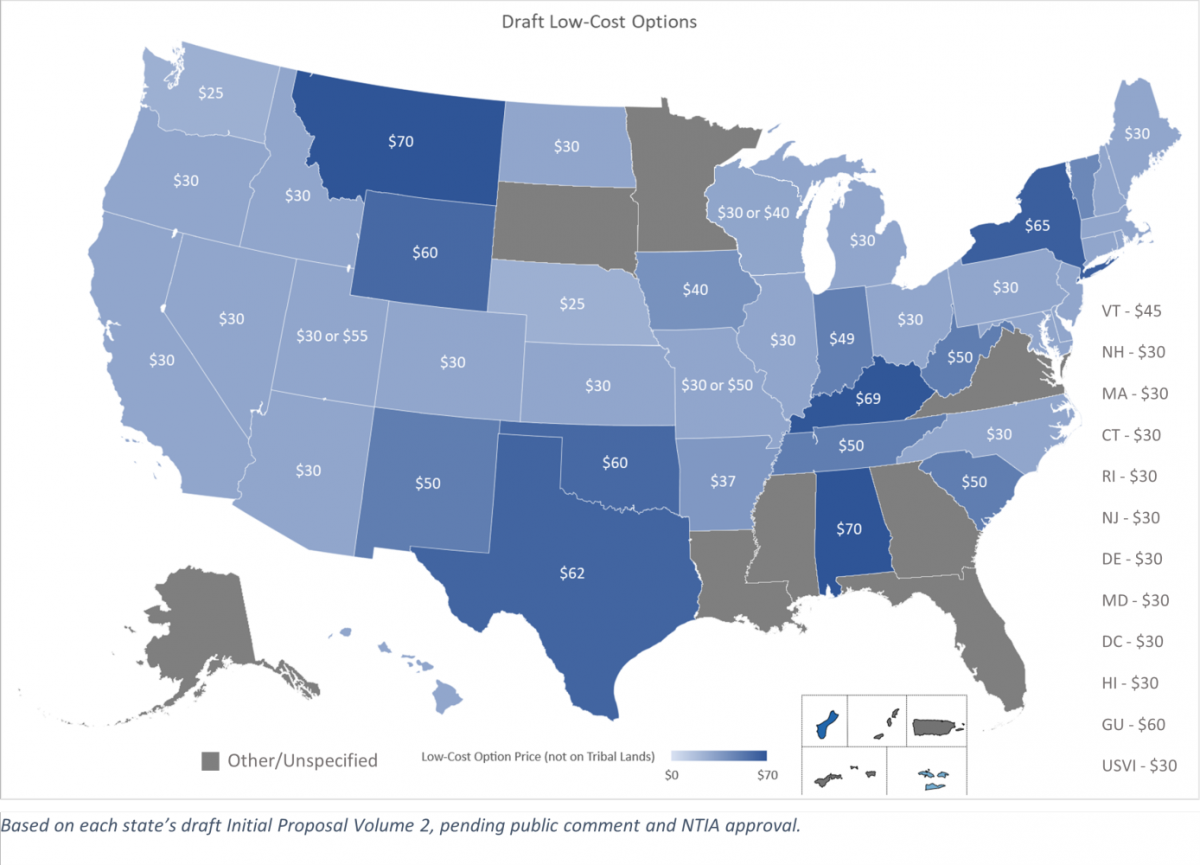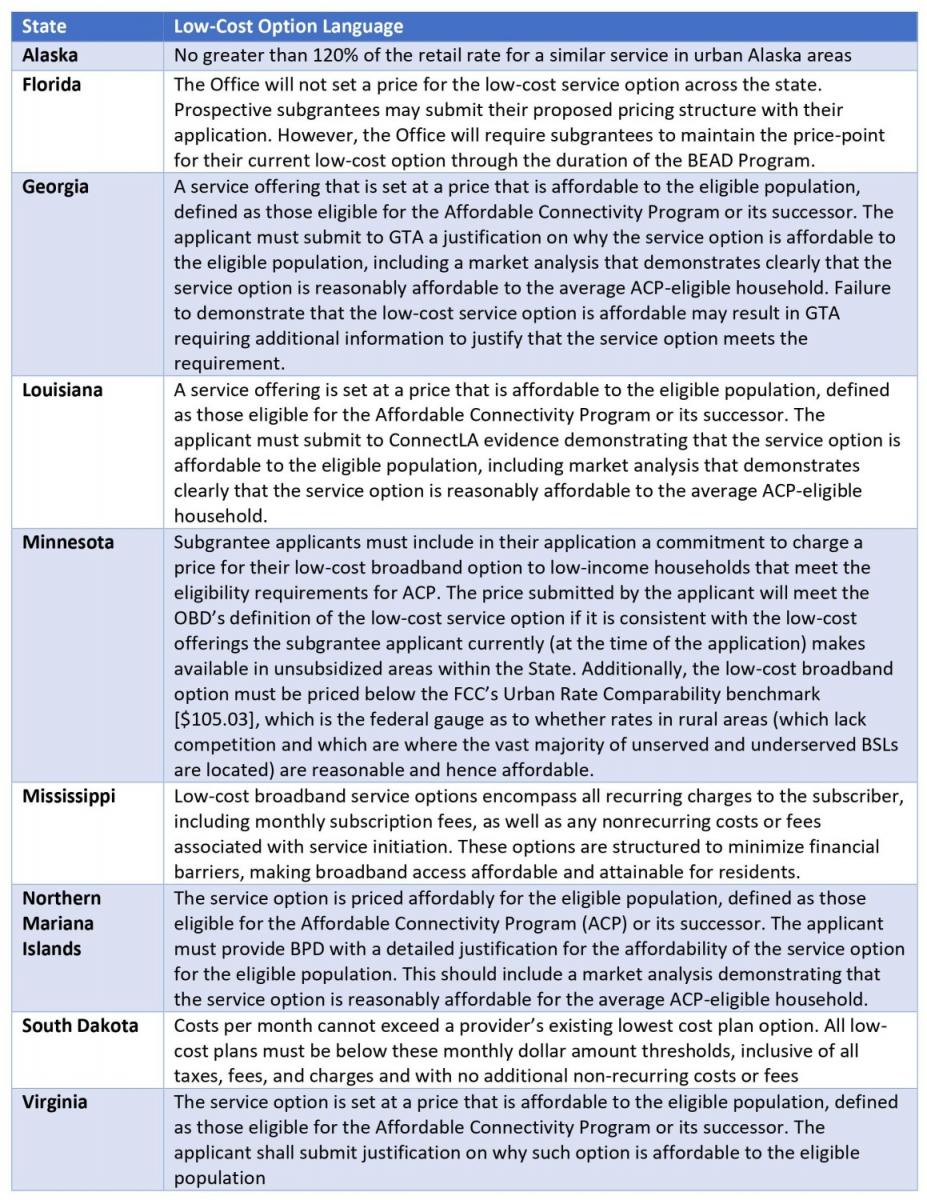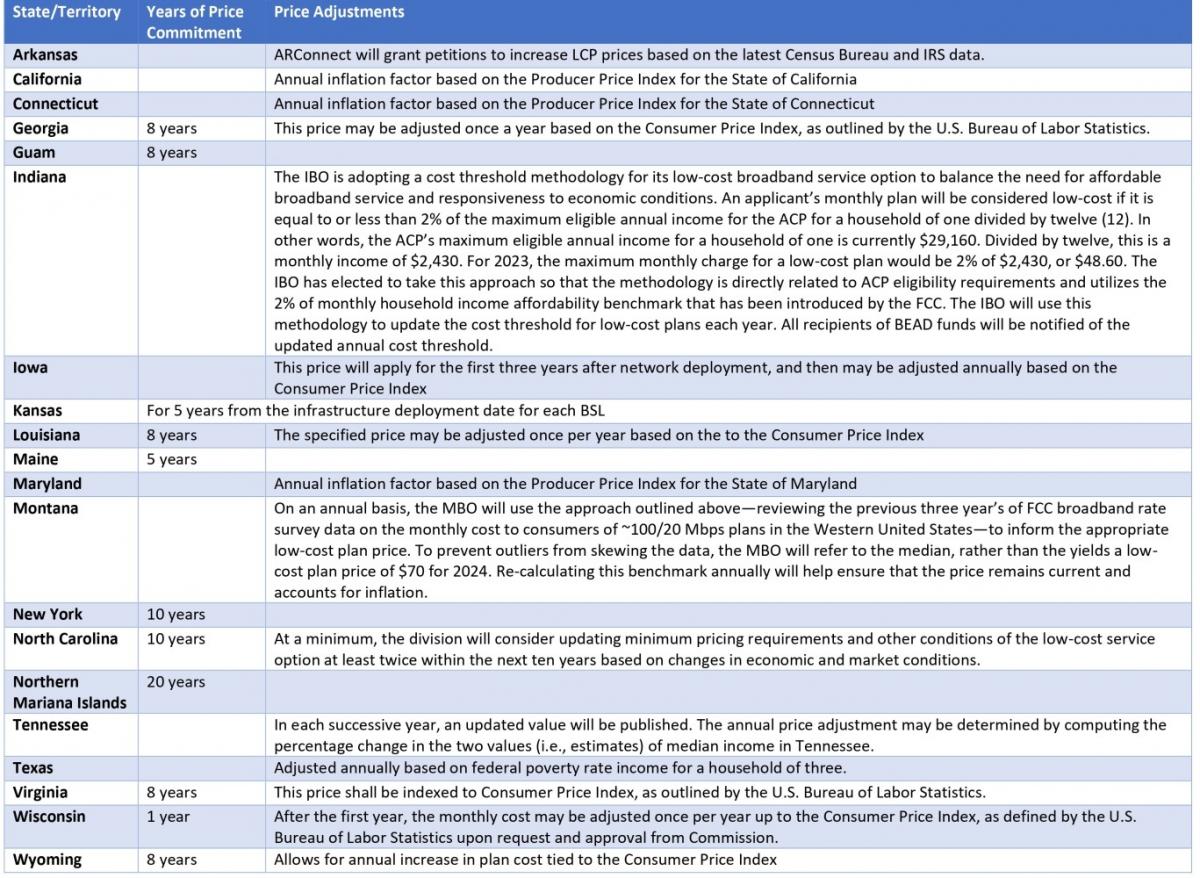Reviewing State (Draft) Low-Cost Options
Monday, December 11, 2023
Digital Beat
Reviewing State (Draft) Low-Cost Options

It’s been said before but always worth repeating: affordability is a barrier for low-income households to get online.
In a 2021 survey from the Pew Research Center, 45 percent of non-broadband users cited price as a reason for not subscribing, with 20 percent citing it as the main barrier. The availability of a low-cost service option, in combination with the Affordable Connectivity Program (ACP) which offers a $30 discount to eligible households ($75 on Tribal Lands), ensures that households are able to afford a high-speed connection.
Under the Broadband Equity, Access, and Deployment (BEAD) Program, providers are required to offer a low-cost option to subscribers who are eligible for ACP. However, the exact definition of what will qualify as “low-cost” is up to state and territory broadband offices to decide. Every broadband office has released a draft of these definitions in their Initial Proposal (Volume 2). In our scan, we are seeing a few different features emerge in these definitions, including having a variable price for different types of providers or geographies, allowing for some cost increases with inflation, using existing prices as a benchmark, and building in a contingency plan if ACP goes unfunded by Congress next year. [Note: These proposals, including the low-cost option definition, are open to public comment and subject to approval from the National Telecommunications and Information Administration (NTIA).]
NTIA’s Model
NTIA will evaluate low-cost options based on the total cost of service to the subscriber, the service characteristics (including the upload and download speeds, data caps, and latency), the ability for subscribers to apply the ACP benefit, and the ability for subscribers to upgrade to any new or more advantageous low-cost service plan in the future. In the BEAD Notice of Funding Opportunity, NTIA suggests broadband offices define the low-cost option as a service offering that:
- costs $30 a month or less, or $75 on Tribal Lands (inclusive of all taxes, fees and charges);
- allows subscribers to apply ACP subsidies to the price;
- provides 100/20 Mbps speeds (unless the FCC benchmark for fixed terrestrial broadband is changed to a higher definition);
- provides latency of no more than 100 milliseconds;
- is not subject to data caps, surcharges, or throttling;
- allows eligible subscribers to upgrade to a new low-cost plan at no cost if one becomes available; and
- requires subgrantees to participate in ACP.
This proposed definition of a low-cost option ensures that ACP eligible subscribers have access to high-quality service plans that offer useful speeds at affordable prices, and do not include any unexpected equipment charges or additional fees. A qualified plan at $30 per month that allows the $30 ACP benefit to be applied creates a service option that is essentially free for eligible, low-income households.
How Broadband Offices are Proposing to Define Low-Cost
Every state and territory broadband office has released their proposed definition for what would qualify as a low-cost option. The below details are as of November 28, 2023, and once again, many of these are still open to public comment, and all are subject to and pending approval from NTIA.

For states that opted to modify NTIA's suggested $30 plan, they took different routes, with some relying on a benchmark of 2 percent of the monthly income of a household under various federal poverty levels (for example, Texas looked at the monthly equivalent of 2 percent of 150 percent of the federal poverty rate income for a household of three), others turning to the FCC's Urban Rate Survey to compare available prices. Notably, some states (shown above as “Other/Unspecified”) have proposed a process that would require providers to submit their current or proposed offerings for review by the office to determine affordability and provide justification.
Unspecified Low-Cost Option Language

A few states have also allowed for different offerings depending on certain conditions. Utah is proposing a $30 offering for providers in urban areas, and a $55 option for rural providers. Similarly, Wisconsin has proposed setting a $30 price point for providers with over 100,000 subscribers, but only requiring providers with fewer than 100,000 subscribers to offer $40 plans. Notably, Missouri is proposing a $30 plan but allowing providers to qualify with a $50 plan if they participate in the ACP device subsidy program, which offers a one-time $100 discount on devices to eligible households. Broadband offices are also proposing to set unique conditions on the number of years these plans may be offered and the other types of fees providers can include. For example, California is proposing a definition that requires the provider to offer eligible households a $30 plan that is inclusive of the cost of the Wi-Fi router and modem. North Carolina limits any non-recurring fees to $50, including installation and equipment.
The low-cost option is required to be available for “the useful life of the network.” Several states have further specified the exact length of time the plan must be offered and any mechanism to consider cost increases, due to inflation or other metrics.
Specific Time Commitments and/or Price Adjustment Mechanisms

With ACP expected to run out of funding without congressional action before April 2024, some states have written contingency plans into their low-cost definitions. For example, North Carolina’s low-cost option states,
Barring a successor program [to ACP], subgrantees will be required to continue offering the low-cost service option to, at a minimum, customers who meet the ACP eligibility criteria. In this case, the subgrantee would assume responsibility for determining eligibility but could avoid that administrative burden by making the low-cost option available to all potential customers rather than just those who would meet the ACP eligibility criteria.
While California’s low-cost option states:
...due to the uncertainty surrounding the continued availability of funding for the ACP, the CPUC will require subgrantees to offer the Low-Cost Broadband Service Option at a price of $15 per month for all income-qualified customers if ACP funding is expended and no successor program guaranteeing an equivalent subsidized price of service for eligible customers is established.
As these plans are finalized and submitted to NTIA for approval, we will be keeping an eye out for any changes.
This article originally appeared on LinkedIn; it is reprinted here with permission of the author.
Jake Varn is Associate Manager of Policy & Engagement at The Pew Charitable Trusts' Broadband Access Initiative. He provides technical assistance to state broadband offices through Pew’s broadband education and training initiative. Before joining Pew, Jake served as a policy analyst for the National Governors Association and for the Bipartisan Policy Center. He is a graduate of the University of Iowa, where he earned a bachelor’s degree in history and international relations.
The Benton Institute for Broadband & Society is a non-profit organization dedicated to ensuring that all people in the U.S. have access to competitive, High-Performance Broadband regardless of where they live or who they are. We believe communication policy - rooted in the values of access, equity, and diversity - has the power to deliver new opportunities and strengthen communities.
© Benton Institute for Broadband & Society 2023. Redistribution of this email publication - both internally and externally - is encouraged if it includes this copyright statement.
For subscribe/unsubscribe info, please email headlinesATbentonDOTorg






